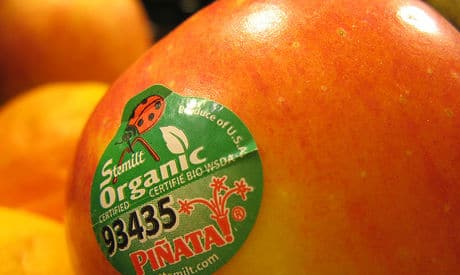
Have you ever wondered when you peeled the label off your apple if its glue was safe to eat? I’ve wondered that every day for about four years and now it’s time to find out.
Perhaps if labels came off without leaving traces of glue or removing good chunks of antioxidant-rich skin I may not have started wondering. Or maybe if I hadn’t seen the Seinfeld episode in which George’s fiance Susan dies after licking 200 wedding invitation envelopes…
Peeling off irritating little produce stickers offends me and adds quite a few minutes to my morning routine when preparing vegetables and fruit for lunch. Some kind label manufacturers add a miniscule tag to the side of the sticker to soothe irritation on the part of the remover. So turn on the light, put your glasses on (if you need to) and look for one. If there’s none, you may still be lucky to find the sticker wrinkled, which gives you a loose edge to pull up. If not, you’re down to taking a deep breath and slicing it off as best you can.
Vegetable and fruit labels can be useful:
- They help us separate conventionally grown from organic produce when shopping.
- They help your till operator identify which apple you’ve chosen, especially nowadays when there are more varieties.
- They also help at home if you want to do a taste-test to compare a pink lady with a similar-looking suncrisp.
Is there a negative side to vegetable and fruit labels?
- Their removal adds a small amount of stress to my day and perhaps to yours.
- They contribute to soil and water pollution.
- And the question we asked at the beginning of this article: Are fruit label glues safe?
We are wise to question all adhesives that come into contact with our bodies because some of them contain substances that are harmful to us; for example, some eyelash glues contain formaldehyde, a known carcinogen.
Some sources, such as Dr. Lipman’s blog, mention that the adhesive on fruit labels is considered to be food grade, however, the FDA’s list of pressure-sensitive adhesives that may be “safely used as the food-contact surface of labels and/or tapes applied to food” includes substances such as BHT and BHA which are suspected carcinogens. In addition, the FDA list is lengthy and contains many other chemicals that I have not yet researched. Therefore, even though we may only take in miniscule amounts of chemicals through label residues, perhaps it’s not worth the risk.Read more about toxic chemicals
What we can do to help:
- Buy from farmers’ markets, CSAs and small neighbourhood fruit markets that don’t sell labeled produce.
- Cut off the little piece of fruit or vegetable skin under the sticker to avoid ingesting adhesive chemical residues.
- Keep labels out of compost because they don’t biodegrade.
- Keep labels out of water systems (sewage, rivers and sea) by throwing them in the garbage before washing food.
- Ask your grocery store if it’s really necessary to have stickers on their fresh produce.
- Here’s a fun suggestion: save labels and send them to a fruit sticker artist like Barry “Wildman” Snyder.
Photo Credit: Bludgeoner86




